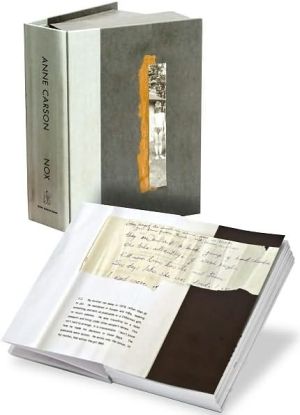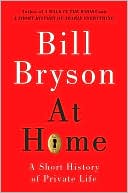Nox
Anne Carson’s haunting and beautiful Nox is her first book of poetry in five years—a unique, illustrated, accordion-fold-out “book in a box.”\ Nox is an epitaph in the form of a book, a facsimile of a handmade book Anne Carson wrote and created after the death of her brother. The poem describes coming to terms with his loss through the lens of her translation of Poem 101 by Catullus “for his brother who died in the Troad.” Nox is a work of poetry, but arrives as a fascinating and unique...
Search in google:
Anne Carson’s haunting and beautiful Nox is her first book of poetry in five years—a unique, illustrated, accordion-fold-out “book in a box.” The Barnes & Noble Review Carson knows, as anyone who's lost someone they love knows, that there will be no end to the trying to make sense, no end to the sorrow and the mystery that come with death. "He refuses, he is in the stairwell, he disappears," she offers on her final page, conjugating her loss in some deeply resonant private language that needs no translation for us to comprehend. Like someone who has died, her creation both bestows a great depth of knowledge and leaves us longing for more.
\ Publishers WeeklyIn order to discuss Carson's latest work—a foldout, Jacob's ladder collage of letters, photographs, and poetry, all housed in a beautiful box—one must first address its resistance to being addressed. Rather, what Carson does (and with furious precision) is impress upon us her grief over a life she cannot recapture—for Carson, this life is her brother's, for whom this collection is both an elegy and a history. What results is a work of astonishing candor, in which Carson manages to define the elegy anew by exploring the lacunae of her brother's life. “It is when you are asking about something,” she writes, “that you realize you have survived it, and so you must carry it, or fashion it into a thing that carries itself.” Carson accomplishes just that, creating a physical record of a life in the form of a book that allows its fragments to carry her brother's absence. To call this art object extraordinary—more than a book, it's a reproduction of a scroll Carson made by hand—would be to understate. What Carson has given us is an act of devotion of such integrity that it carries its grief on its back. (Apr.)\ \ \ \ \ The MillionsNox’s intelligence, sadness, and wry humor alone might be enough, but its form takes me even more. To read is sensual. You handle the folds, opening one winged pair at a time or in quick, slinky unfurlings. And this read is not linear, with pages dissolving behind you as you turn, but spatial, more like letting your eyes wander a room. With the whole book unfurled you see it entire and make links among images, like a staircase or an egg that reappear folds apart, and among words like ash, festive, blush. You prowl the book itself.\ \ \ New York Review of BooksRarely has forking over thirty dollars felt like such a solemn act of memorial.\ \ \ \ \ The New York Review of BooksCarson has . . . created an individual form and style for narrative verse. . . . Seldom has Pound’s injunction ‘Make It New’ been so spectacularly obeyed.\ \ \ \ \ The New York Times MagazineAnne Carson is a poet who likes to get under people’s skin.— Melanie Rehak\ \ \ \ \ The New York Times Book ReviewTrust me: it's an Anne Carson book. Maybe her best....The book is totally recherché and weirdly clear, lingered over and neatly boxed. Precious in the word’s best sense.— Ben Ratliff\ \ \ \ \ Library JournalCarson (Autobiography of Red) traverses the intimate territory of familial past with text, photographs, drawings, and other ephemera that explore her relationship with her brother Michael, who fled to Europe to avoid a jail sentence on drug charges and died years later in Copenhagen. A scholar of ancient Greek, Carson uses the definitions and etymologies of Greek terms to ground the story of her brother's life and death. These definitions, which appear on right-hand pages, often serve a function similar to that of a Greek chorus—they foreshadow or illuminate various parts of Michael's story, whose text appears on the left-hand pages. Intercut with graphical elements, this book differs from many avant-garde texts in that it compels the reader to use a range of different sensory faculties to interpret the story being told. VERDICT Equal parts visual art, verse, and memoir, this bold tale of exile and estrangement will be indispensable for poetry readers.—Chris Pusateri, Jefferson Cty. P.L., Lakewood, CO\ \ \ \ \ Michael Dirda…moving yet strikingly unconventional…The assembled "text" of Nox itself is a mosaic of memories of Michael—both the "starry lad he was" and the "windswept spirit" he became—illustrated with family photographs, bits of artwork and various typographical scraps and orts…Carson is famously reticent about her private life, but Nox allows us to glimpse a bit of it.\ —The Washington Post\ \ \ \ \ Ben RatliffAnne Carson's new book comes in a box the color of a rainy day, with a sliver of a family snapshot on the front. Inside is a Xerox-quality reproduction of a notebook, made after the death of her brother, including text and photographs and letters, pasted-in inkjet printouts, handwriting, paintings and collage. Nox has no page numbers, and it's accordion-folded. It carries a whiff of visual art multiple or gift shop souvenir or Griffin & Sabine. But trust me: it's an Anne Carson book. Maybe her best…The book is totally recherché and weirdly clear, lingered over and neatly boxed, precious in the word's best sense.\ —The New York Times\ \ \ \ \ The Barnes & Noble ReviewNo one does fragments -- glimpses of ontological questions, of minutiae, of pop culture, ancient civilization, of passion, sorrow, life and death -- quite like Anne Carson. The most obvious examples are her translations of the poet Sappho's fragments in the luminous If Not, Winter (2002), but these are really only the continuation of a long fascination with all that remains unknown. As far back as her earliest poetry and essay collections, Eros the Bittersweet (1986), Glass, Irony and God (1992), and Plainwater (1995), Carson has always, alongside more traditional prose and verse, trafficked in what remains necessarily partial and unfinished in life. She faces the voids that many of us prefer to turn away from, and this gives her work a rare urgency. After all, as she writes while trying to craft a final resting place for her brother, the subject of her extraordinary new book, Nox, "We want other people to have a centre, a history, an account that makes sense. We want to be able to say This is what he did and Here's why."\ Of course, we cannot, though in Nox Carson gives it perhaps the best try I've ever witnessed. What she arrives at is all the more impressive for how little she has to go on. Nox is a reproduction of the scrapbook Carson put together after her brother, whom she hadn't seen for over twenty years, died in 2000, just as she was planning to visit him after a recent reconnection. A collage of words, stamps, old letters, photographs, and artwork in various mediums -- all copied with amazing effect onto a continuous accordion-folded length of paper and encased in what transcends its boxy gray cardboard form to become nothing less than a sarcophagus -- it's Carson's "epitaph" to her lost sibling. On its cover, he stands guard in a photo taken at about ten years of age, obscured even then by a pair of dark swim goggles that cover most of his face. He "ran away in 1978, rather than go to jail," she writes. "He was traveling on a false passport and living under other people's names. This isn't hard to arrange. It is irremediable." This fragment, one of the few pieces of hard information we get, appears on four pages in a row, accompanied by various snippets of the one letter he wrote home to Carson's mother during his absence, as Carson tries to give her story a start.\ It turns out, as the effort to impose order so often does, to be a false one. "I wanted to fill my elegy with light of all kinds," Carson admits in the first prose section of the book, labeled "1.0" and offered up in a plain font on a small scrap of paper with rough edges that looks as though you could easily pick it right up off the page. "But death makes us stingy. There is nothing more to be expended on that, we think, he's dead….No matter how I try to evoke the starry lad he was, it remains a plain, odd history. So I began to think about history."\ For Carson, "history" has always meant classics. (She is a classicist by training, and, as she puts it in her marvelously understated author bio, she "teaches ancient Greek for a living," which is as perfect an example of Carson's mysterious, jaunty style as anything that's appeared between book covers.) So here, too, she turns to Catullus, whose elegy for his dead brother appears, slightly smudged and on yellowed paper, in the original Latin, as the first item in Nox. As the scanty details of her brother's life unfurl, alongside them run translations of each word in Catullus's poem, a record of Carson's work that provides its own wealth of fragmentary attempts at meaning in an echo of her efforts to grasp her brother's life. Each one adds new layers to our understanding of her grief. For example: "multas: multa lux, broad daylight, multa nox: late in the night, perhaps too late" and "ipsum: himself (herself, itself, oneself, etc.) as opposed to others…the actual himself (herself, etc.) as opposed to persons more remotely connected; the real state of affairs, the fact, reality…ipse tristis the sad one."\ It isn't until more than halfway through the book that we get the complete translation of the poem (it appears on the endpaper once more, blurred virtually beyond reading), and even then, she confesses, "No one (even in Latin) can approximate the Catullan diction, which at its most sorrowful has an air of deep festivity, like one of those trees that turns all its leaves over, silver, in the wind. I never arrived at the translation I would have liked to do of poem 101. But over the years of working at it, I came to think of translating as a room, not exactly an unknown room, where one gropes for the light switch. I guess it never ends. A brother never ends."\ This is where Carson's gift for fragments gathers force. While the Catullus poem is moving in its own right, it bears the mark of closure -- its final words are "farewell and farewell" -- and as such is final. Carson's gestures towards understanding are ever in motion, like those gilded leaves, and the bits and pieces that make up her grief take on a shimmering currency in her hands. They may not add up to a whole in the traditional sense, but they overwhelm Catullus's elegy by a landslide with their raw, open-edged emotion.\ Carson knows, as anyone who's lost someone they love knows, that there will be no end to the trying to make sense, no end to the sorrow and the mystery that come with death. "He refuses, he is in the stairwell, he disappears," she offers on her final page, conjugating her loss in some deeply resonant private language that needs no translation for us to comprehend. Like someone who has died, her creation both bestows a great depth of knowledge and leaves us longing for more.\ --Melanie Rehak\ \ \








